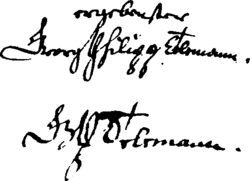Georg Philipp Telemann
![]()
Telemann is a redirect to this article. For other meanings, see Telemann (disambiguation).
Georg Philipp Telemann (* 14 Marchjul. / 24 March 1681greg. in Magdeburg; † 25 June 1767 in Hamburg) was a German composer of the Baroque period. He significantly shaped the musical world of the first half of the 18th century through new impulses, both in composition and in musical outlook.
Georg Philipp Telemann spent his youth in Hildesheim from 1697. Here he received significant encouragement that decisively shaped his musical development. In the four school years at the Gymnasium Andreanum he learned several instruments and it was here that he composed the Singing and Sounding Geography. Afterwards he received numerous commissions for further compositions.
Later he learned music largely through self-study. He had his first major compositional successes while studying law in Leipzig, where he founded an amateur orchestra, conducted opera performances, and rose to become music director of the then university church. After brief appointments at the courts of Sorau and Eisenach, Telemann was appointed municipal music director and kapellmeister of two churches in Frankfurt am Main in 1712, alongside which he began self-publishing works. From 1721 he occupied one of the most prestigious musical posts in Germany as Cantor Johannei and Director Musices of the city of Hamburg, and a little later he took over the direction of the opera. Here, too, he continued to maintain contacts with foreign courts and organized regular public concerts for the city's upper classes. Telemann finally achieved international fame with an eight-month stay in Paris in 1737/38.
Telemann's musical legacy is extraordinarily extensive and encompasses all the musical genres common in his time. Typical of Telemann are vocal melodies, imaginatively used timbres, and, especially in his later works, unusual harmonic effects. The instrumental works are often strongly influenced by French and Italian, occasionally also folkloristic Polish influences. In the course of the changing ideals of cultural history, Telemann's oeuvre came under critical scrutiny in the 19th century. Systematic research into the complete works only began in the second half of the 20th century and continues because of their great extent.
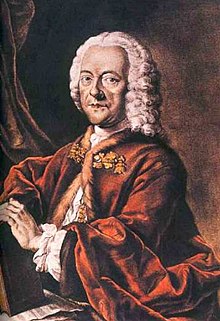
Georg Philipp Telemann, coloured aquatint by Valentin Daniel Preisler after a lost painting by Ludwig Michael Schneider (1750)
Live
Childhood and youth
Telemann came from an educated family; his father and a number of other ancestors had studied theology. Apart from Telemann's paternal great-grandfather, who was a cantor for a time, however, none of his family had any direct connection with music. His father, Pastor Heinrich Telemann, died on 17 January 1685, only 39 years old. His mother, Johanna Maria Haltmeier, was also born in a pastor's house and was four years older than her husband. Of the six children, only the youngest son, Georg Philipp, and Heinrich Matthias Telemann, born in 1672, reached adulthood. This brother died in 1746 as an Evangelical Lutheran pastor in Wormstedt near Apolda.
Georg Philipp attended the Gymnasium in the old town and the school at Magdeburg Cathedral, where he received instruction in Latin, rhetoric, dialectic and German poetry. Telemann, a young pupil, performed particularly well in Latin and Greek. His comprehensive general education is evidenced, for example, by the German, French and Latin verses he wrote himself, which he reproduced in his later autobiography. In addition, Telemann mastered the Italian and English languages well into old age.
Since public concerts were still unknown in Magdeburg at that time, the secular music performed in the school complemented the church music. In particular, the old city school, which had concertante musical instruments and held regular performances, was of great importance for the cultivation of music in the city. In the smaller private schools that Telemann attended, he also learned various instruments such as the violin, recorder, cyther and clavier through self-study. He showed considerable musical talent and at the age of ten began to compose his first pieces - often secretly and on borrowed instruments. He owed his first solid musical experiences to his cantor Benedikt Christiani. After only a few weeks of singing lessons, Telemann, who was ten years old at the time, was already in a position to stand in for the cantor, who preferred composing to teaching, in the upper classes. Apart from a fortnight's instruction in piano playing, he received no further musical instruction. His zeal was dampened by his mother, widowed since 1685, who disapproved of his involvement with music because she considered the musical profession inferior.
At the age of only twelve, Telemann composed his first opera, Sigismundus, to a libretto by Christian Heinrich Postel. In order to dissuade Georg Philipp from pursuing a musical career, his mother and relatives confiscated all his instruments and sent him to school in Zellerfeld in late 1693 or early 1694. She probably did not know that the superintendent there, Caspar Calvör, was intensively involved with music in his writings and promoted Telemann. Calvör had attended the University of Helmstedt with Telemann's father. He encouraged Telemann to take up music again, but also not to neglect school. Almost weekly Telemann composed motets for the church choir. In addition, he also wrote arias and occasional music, which he submitted to the town piper.
In 1697 Telemann became a pupil at the Gymnasium Andreanum in Hildesheim. Under the guidance of the director Johann Christoph Losius, he perfected his musical education and learned - again largely as an autodidact - the organ, violin, viola da gamba, transverse flute, oboe, shawm, double bass and bass trombone. In addition, he composed vocal works for the school theatre. He received further commissions to compose for the services of the St. Godehardi monastery from the Jesuit church music director of the city, Father Crispus.
Telemann was also influenced by musical life in Hanover and Braunschweig-Wolfenbüttel, where he came into contact with French and Italian instrumental music. The experiences gained at this time were to shape large parts of his later work. He also became acquainted with the Italian-influenced styles of Rosenmüller, Corelli, Caldara and Steffani during clandestine music lessons.
Years of study in Leipzig
In 1701 Telemann finished his school education and enrolled at the University of Leipzig. Under pressure from his mother, he took it upon himself to study law as he had intended and to no longer concern himself with music. At least this is what he asserted in his autobiography; nevertheless, the choice of Leipzig, which was considered the bourgeois metropolis of modern music, does not seem to have been accidental. Already on his way to Leipzig, Telemann stopped in Halle to meet the then sixteen-year-old George Frideric Handel. With him he established a friendship that was to last his entire life. Telemann wrote that he initially concealed his musical ambitions from his fellow students. Allegedly, however, Telemann's music-loving roommate found a composition among his hand luggage thanks to a (probably fictitious) coincidence, and he had it performed the following Sunday in St. Thomas Church. Thereupon Telemann was commissioned by the mayor to compose two cantatas per month for the church.
|
Telemann's signature (1714 and 1757) |
Only one year after entering the university, he founded a 40-piece amateur orchestra (Collegium musicum) for the musical students, which also gave public concerts and performed in the newly consecrated New Church. In contrast to similar student institutions of this kind, the Collegium remained in existence after Telemann's departure and continued under his name. Under the direction of Johann Sebastian Bach, from 1729 to 1739, the "Telemannian" Collegium Musicum performed concerts of works by Bach and other contemporary composers at Café Zimmermann, which had a great influence on the musical life of the city.
In the same year Telemann conducted performances of the opera house, in which many members of the Collegium also took part, and of which he remained the main composer until its closure. To the performances he played the basso continuo and occasionally sang. Irritated by Telemann's growing reputation, the official city music director Johann Kuhnau accused him of having exerted too great an influence on sacred music with his secular works, and refused to allow his choristers to participate in the opera performances. In 1704, after a successful application, Telemann was hired as music director by the Paulinerkirche, then the city's university church. However, he gave up the associated organist position to students.
Telemann made two trips from Leipzig to Berlin. In 1704 he received an offer from Count Erdmann II von Promnitz to succeed Wolfgang Caspar Printz as Kapellmeister at the court of Sorau in Lower Lusatia - why he attracted the count's attention is unknown. Thereupon the city, which appreciated the new style of composition, offered Telemann the Thomaskantorat and Kuhnau's succession. It is possible that the tensions that arose between Kuhnau and Telemann induced the latter to leave Leipzig at an early stage.
Sorau and Eisenach
In June 1705 Telemann began his work in Sorau. The count was a great admirer of French music and saw in Telemann a worthy successor to the Versailles school of music influenced by Lully and Campra, some of whose compositions he brought back with him on a trip to France and which Telemann now studied. In Sorau Telemann met Erdmann Neumeister, whose texts he later set to music and whom he was to meet again in Hamburg. On trips to Cracow and Pleß he learned to appreciate Polish and Moravian folklore, as it was probably performed in inns and at public events.
In 1706 Telemann left Sorau, which was threatened by the invasion of the Swedish army, and went to Eisenach, presumably on the recommendation of Count Promnitz, who was related to the ducal families of Saxony. There he became concertmaster and cantor at the court of Duke Johann Wilhelm in December 1708 and founded an orchestra. He often played together with Pantaleon Hebenstreit. Telemann also met the music theorist and organist Wolfgang Caspar Printz as well as Johann Bernhard and Johann Sebastian Bach. In Eisenach he composed concerts for various instrumentations, about 60 to 70 cantatas as well as serenades, church music and "operettas" for festive occasions. He usually wrote the text for these himself. In addition, there were about four or five years of cantatas for church services. As a baritone he was involved in the performance of his own cantatas.
In October 1709 Telemann married Amalie Luise Juliane Eberlin, a lady-in-waiting to the Countess of Promnitz. Shortly before, he had been appointed secretary by the duke - a high honor at that time. Telemann's wife, a daughter of the composer Daniel Eberlin, died of childbed fever in January 1711 during the birth of their first daughter.
Frankfurt am Main
Perhaps because he was looking for new challenges, perhaps to be independent of the nobility, Telemann applied for a job in Frankfurt am Main. There, in February 1712, he was appointed municipal music director and Kapellmeister of the Barfüßer Church, and a little later also of the Katharinenkirche. He completed the cantatas he had begun in Eisenach and composed five more. In addition, he was responsible for the instruction of several private pupils. As in Leipzig, Telemann was not content with these duties in Frankfurt. In 1713 he took over the organization of the weekly concerts as well as various administrative tasks of the distinguished Stubengesellschaft Zum Frauenstein in Haus Braunfels on the Liebfrauenberg, where he himself also lived. In addition, the Eisenach court appointed Telemann as Kapellmeister "von Haus aus", so that he retained his title, but only delivered cantatas and occasional music to the court and to the churches. This happened until 1731.
During his time in Frankfurt, in addition to cantatas, Telemann composed oratorios, orchestral and chamber music, much of which was published, as well as music for political ceremonies and wedding serenades. However, he found no opportunity to publish operas, although he continued to write for the Leipzig opera.
In 1714 Telemann married the 16-year-old Maria Catharina Textor (1697-1775), the daughter of a council cornet clerk. From the following year he self-published his first printed works. On a trip to Gotha in 1716, Telemann was offered a position as Kapellmeister by Duke Friedrich. The Duke not only promised him to keep his job as Kapellmeister for the Eisenach court, but also induced the Duke of Saxe-Weimar to promise Telemann another Kapellmeister position. This would have made Telemann, in a sense, chief kapellmeister of all Saxon-Thuringian courts.
A letter addressed to the Frankfurt Council, in which Telemann issued an ultimatum regarding his salary in polite terms, demonstrates his diplomatic skills. He remained in Frankfurt and secured a salary increase of 100 gulden. Together with his income from the Frauenstein Society and fees for occasional compositions, Telemann's annual income amounted to 1,600 florins, making him one of the best paid in Frankfurt.
During a visit to Dresden in 1719, he met Handel again and dedicated a collection of violin concertos to the violin virtuoso Pisendel. Telemann continued to write works for Frankfurt every three years until 1757, after he had left the city.
Early days in Hamburg
In 1721 Telemann accepted the offer to succeed Joachim Gerstenbüttel as Cantor Johannei and Director Musices of the city of Hamburg. Presumably Barthold Heinrich Brockes and Erdmann Neumeister suggested his name. Telemann, however, had already been associated with the Hanseatic city earlier, as he had already been involved in one or two operas for the opera house at the Gänsemarkt. As the city's musical director, Telemann worked at the five large Lutheran city churches, among others - with the exception of the cathedral, for which Johann Mattheson was responsible. Telemann's solemn inauguration took place on 16 October. It was only here, with the opportunity to compose and perform works of all forms, that his main creative phase, which lasted 46 years, began. The obvious translation of Telemann's title as "cantor" is misleading in that his actual cantorial work at the Johanneum was limited to occasional festive cantatas and the musical decoration of other school actus.
In his new post, Telemann committed himself to composing two cantatas a week and one Passion a year, although in later years he drew on earlier works for his cantatas. In addition, he composed numerous pieces of music for private and public occasions, such as memorial days and weddings. The office of Cantoris Johannei was also connected with an activity as music teacher of the Johanneum; however, Telemann did not fulfil his obligations for extra-musical instruction himself. In addition, he rebuilt the Collegium musicum, which had already been founded by Matthias Weckmann in 1660, but which had since ceased to give concerts. He sold the tickets personally.
Even in his new hometown, Telemann did not initially break off his connections with Thuringia. He served the Duke of Saxe-Eisenach as an agent from 1725 and reported news from Hamburg to the Eisenach court. It was not until 1730 that he relinquished the position to the physician Christian Ernst Endter.
In Hamburg, Telemann resumed his activities as a publisher. In order to save costs, he either engraved the copper plates himself, or he used a method developed by William Pearson in 1699 and until then only used in England, in which he recorded the notes with pencil mirror-inverted on a plate of hard tin. The printing plate was then scraped and peeled off by another. In the process Telemann managed nine to ten plates a day. By 1740 he had self-published 46 works of music, which he sold to booksellers in several German cities as well as in Amsterdam and London. It was also possible to order scores from the composer himself; until 1739 regularly supplemented catalogues informed the music lover. Among the works are, for example, Twelve Fantasies for Viola da Gamba solo, which he printed in 1735.
Telemann, however, had more trouble in the Hanseatic city than he had expected. The council printer refused Telemann a share of the proceeds from the sale of the cantata and Passion text booklets. Telemann was not to emerge victorious from the ensuing protracted legal dispute until 1757. In addition, the College of Senior Citizens complained when Telemann wanted to perform some cantatas in a noble inn (meaning the tree house in Hamburg harbor) in 1722. Together with the inadequate pay and his too small apartment, these incidents induced him to apply for the position of Thomaskantor in Leipzig after Kuhnau's death. Among the six applicants, he was unanimously elected, whereupon he submitted a letter of resignation on September 3, 1722, which, in contrast to his letter to the Frankfurt Council, appears to be quite serious. Since the Hamburg council now increased his salary by 400 marks lübisch, Telemann declined the position as Thomaskantor a little later and remained in Hamburg. His total annual income thus amounted to about 4,000 Marks Lübisch.
New start in Hamburg
Only now did Telemann's activities in Hamburg flourish in all areas. In the same year, he took over the direction of the opera for an annual salary of 300 talers. He continued in this position until the house was closed in 1738. Of the approximately 25 opera works written during this period, most are lost. In 1723 Telemann took on an additional position as Kapellmeister for the court of the Margrave of Bayreuth. There he delivered instrumental music from time to time as well as one opera a year. Telemann's concert performances usually took place in the Drillhaus, the parade hall of the Hamburg Citizen's Guard, and were reserved for the higher classes because of the high entrance fee. Telemann provided almost exclusively his own compositions for his performances - apart from those in the opera house.
In 1728 Telemann, together with Johann Valentin Görner, founded the first German music journal, which also contained compositional contributions by various musicians. The faithful music master was intended to promote music making at home and appeared bi-weekly. In addition to Telemann and Görner, eleven other contemporary musicians, including Keiser, Bonporti and Zelenka, contributed compositions to the journal. Further compilations for teaching purposes followed.
In twelve years Telemann's wife Maria Catharina gave birth to nine children, two of whom died. With almost permanent pregnancy, she had to support a growing household of up to twelve people, including Georg Philipp Telemann's daughter from his first marriage and three other people (presumably a maid, a tutor and a pupil of Telemann's) as well as Telemann himself. Ten years after the birth of their last child, the couple separated after Telemann discovered that his wife had lost 5,000 reichstaler (15,000 marks lübisch) in gambling. It is believed that the divorce was pronounced because of Maria Catharina's adultery. She went back to Frankfurt in 1735, while in Hamburg it was rumored that she had died. Unbeknownst to Telemann, some Hamburg citizens had a fundraising campaign organized to save him from bankruptcy. The fact that Telemann nevertheless managed to satisfy his most pressing creditors mainly out of his own pocket, and that he afforded himself several stays at a spa in Bad Pyrmont - apparently granted by the city - proves that he was a man of means.
Trip to Paris and late years
Following a long-cherished wish, Telemann visited Paris in the autumn of 1737 at the invitation of a group of musicians there (Forqueray, Guignon and Blavet). In Hamburg he was represented by Johann Adolf Scheibe. With the Paris performances of his works, Telemann finally achieved international fame - he was the first German composer to be allowed to present himself in the public concerts of the Concert Spirituel. Seven of his works had already been available in Paris as pirated editions, then the king granted him a 20-year exclusive right to publish his works.
Telemann returned in May 1738. His reputation had also grown in Germany as a result of his successes in Paris. In 1739 he was admitted to the Correspondent Society of Musical Sciences, founded by Lorenz Mizler, which dealt with questions of music theory.
In a newspaper advertisement published in October 1740, Telemann offered for sale the printing plates of 44 works he had published himself, as he now wished to concentrate on the publication of didactic writings. Comparatively few compositions survive from the following 15 years. Telemann increasingly used unusual combinations of instruments and novel harmonic effects. Outside of his duties, he devoted himself to collecting rare flowers.
From the period after 1755, three large oratorios and other sacred and secular works have survived. Telemann's eyesight deteriorated visibly, and he also suffered from leg ailments. More and more often he called on his grandson Georg Michael, who was also composing, to help him with his writing. Telemann's humour and innovative power did not suffer from his fatigue. He composed his last work, a St Mark Passion, in 1767. On 25 June, at the age of 86, Telemann died as a result of pneumonia. He was buried in the cemetery of the St. Johannis monastery, where today the Rathausmarkt is located. There, a memorial plaque to the left of the entrance to the town hall commemorates him. His successor in office was his godson, Carl Philipp Emanuel Bach.
More details have come down to us about Telemann's life and work than about many of his contemporary colleagues. In addition to about 100 letters, poems, prefaces and various articles by the composer have survived. The most important textual sources, however, are - despite their errors - his three autobiographies, which he wrote at the request of the music scholars Mattheson (1718 and 1740) and Johann Gottfried Walther (1729). The periods of his life in Sorau and Eisenach, as well as after the publication of the last autobiography, are hardly described in the textual sources originating from Telemann himself, but can be roughly reconstructed from indirect references in other documents.

Memorial plaque in front of Hamburg City Hall
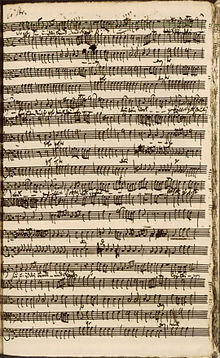
Final chorus of the Oratorio of the Captain's Music (1730)
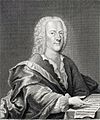
Telemann, copper engraving by Georg Lichtensteger (c. 1745)

Telemann's request for dismissal to the Hamburg councillors in 1722
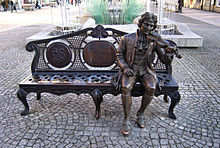
Telemann sculpture in Żary (Sorau)
See also
- List of Telemann's operas
- List of Telemann Cantatas
Search within the encyclopedia
